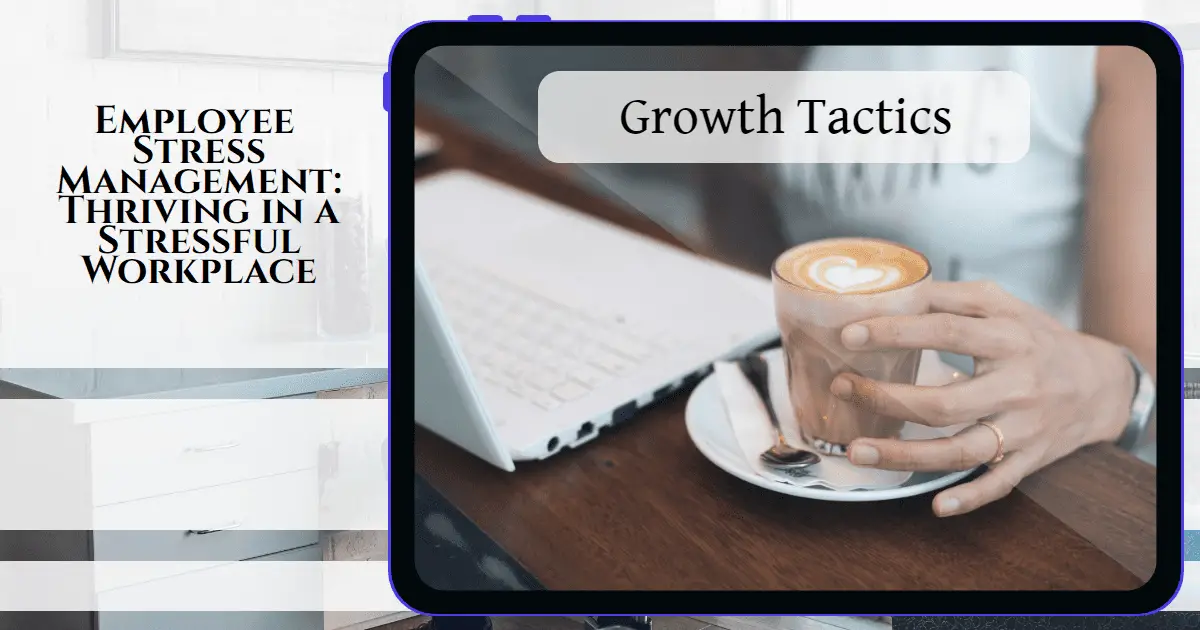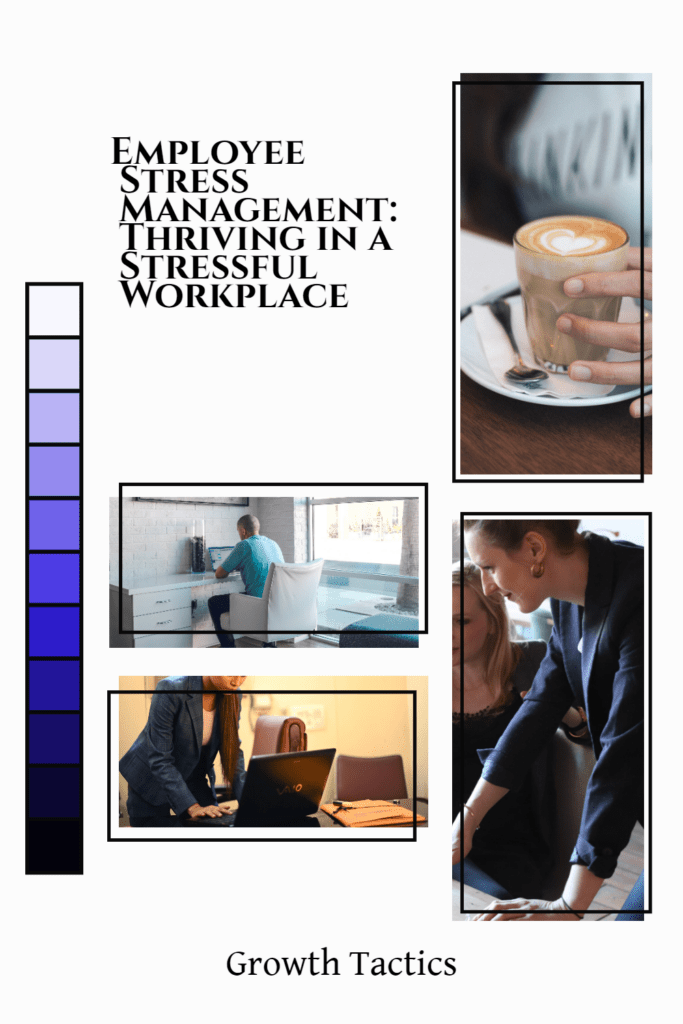In today’s fast-paced work environment, employee stress management has become a critical aspect of maintaining a healthy and productive workforce. The workplace can be a significant source of stress, impacting employees’ mental and physical well-being.
In this blog post, we’ll explore effective strategies and actions employers can take to help reduce workplace stress and support their employees’ overall well-being.
Understanding Workplace Stress
Workplace stress is the emotional and physical strain that can arise from the demands and pressures of our jobs. It’s that feeling we get when we have too much on our plates, unrealistic deadlines, or when we constantly feel underappreciated or unsupported.
Now, it’s important to note that not all stress is bad. In fact, a little bit of stress can be motivating and push us to perform at our best.
But when stress becomes chronic, overwhelming, and starts affecting our health and happiness, it’s time to pay attention and take action.
Understanding the Difference Between Good Stress and Bad Stress
Good Stress: Stepping into the Spotlight
Believe it or not, some stress can actually be beneficial.
Good stress, also known as eustress, is that little burst of energy and excitement we feel when we’re faced with a stimulating situation. It can motivate us, help us perform at our best, and even enhance our overall well-being.
So, when does stress go from distress to eustress? Let’s take a closer look:
Motivation and Focus: Have you ever felt that surge of adrenaline before a big presentation, an important sports game, or a heart-pounding deadline?
That’s eustress at work, my friend. It can help sharpen our focus, enhance our performance, and push us to achieve our goals.
Personal Growth: Stepping out of our comfort zones can be challenging, but it can also be incredibly rewarding.
Good stress can push us to take on new experiences, learn and grow, and discover our hidden strengths and capabilities. It’s like stretching our mind and soul.
Sense of Accomplishment: Ever notice how amazing it feels when you conquer a challenge you initially thought was impossible?
Good stress can lead to a sense of accomplishment, boost our confidence, and leave us feeling proud of our achievements. It’s like a sweet victory dance for our soul.
Bad Stress: The Uninvited Guest
Now, let’s shift gears and talk about bad stress, also known as distress. This is the stress that overstays its welcome and wreaks havoc on our well-being.
It lingers like a dark cloud, bringing us down and leaving us feeling overwhelmed. Here are some signs that stress has crossed over into the distress zone:
Chronic Peril: Distress is like being stuck in a perpetual state of fight-or-flight. It’s when the stressors in our lives become constant and unrelenting.
This can lead to physical and emotional strain, impacting our health, relationships, and overall happiness.
Negative Impact: When stress starts interfering with our everyday lives, causing disruptions and distress, it’s a red flag.
It can manifest as sleep disruptions, decreased productivity, mood swings, and even physical symptoms like headaches or digestive issues. It’s like a menacing storm that won’t pass.
Feeling Overwhelmed: If we constantly feel like we’re drowning in obligations, responsibilities, and demands, it’s a sure sign that distress has taken hold.
It leaves us feeling depleted, exhausted, and like we’re barely keeping our heads above water.
The Impact of Workplace Stress
Workplace stress can spill over into other areas of our lives, affecting our relationships, sleep, and overall well-being. It can manifest in a variety of ways, including:
Physical Symptoms: Headaches, fatigue, stomach issues, and muscle tension are just a few of the physical symptoms that can result from workplace stress.
Emotional Challenges: Stress can leave us feeling overwhelmed, irritable, anxious, or even depressed. Our emotions can feel like a rollercoaster, making it difficult to navigate day-to-day tasks.
Cognitive Struggles: When stress takes over, concentrating, making decisions, and solving problems can become more challenging.
Decreased Productivity: Surprisingly, high levels of stress can actually reduce our productivity. It’s hard to give our best when we’re constantly feeling drained and overwhelmed.
Common Sources of Work Stress
Let’s talk about work stress, shall we? It’s like that unwelcome guest who shows up unannounced and overstays their welcome. We’ve all been there, right? It can really knock the wind out of our sails and leave us feeling drained and overwhelmed.
But here’s the thing: work stress is not something we need to just accept as a part of our lives.
By understanding the common sources of work stress, we can start to tackle them head-on and reclaim our sanity. So, grab a cup of tea (or your beverage of choice) and let’s dive in!
1. Heavy Workloads
One of the primary culprits for work stress is having a heavy workload. When our to-do list is a never-ending abyss of tasks, it can feel impossible to catch our breath.
We find ourselves working long hours, sacrificing personal time, and feeling the constant pressure to meet unrealistic deadlines.
2. Lack of Control
Feeling like we have no control over our work can also contribute to our stress levels. Whether it’s micromanagement from our superiors or being given tasks that are outside of our expertise, the lack of autonomy can leave us feeling trapped and undervalued.
3. Poor Work-Life Balance
Achieving a healthy work-life balance can seem like an elusive dream. We find ourselves glued to our screens, answering emails late into the night, and neglecting our personal relationships and hobbies.
This imbalance can take a toll on our mental health and relationships, leaving us feeling exhausted and disconnected.
4. Unclear Expectations
Have you ever been in a situation where you feel like you’re constantly guessing what your boss or colleagues want from you?
It’s like trying to solve a puzzle without all the pieces. Unclear expectations can lead to confusion, frustration, and a constant fear of falling short.
5. Lack of Support or Recognition
Humans are social creatures, and we thrive on connection and support. When our workplace lacks a supportive environment or fails to recognize our hard work and achievements, it can leave us feeling unappreciated and undervalued.
This, in turn, adds to our stress levels and can lead to a decrease in motivation and productivity.
6. Poor Communication
Communication is the glue that holds any relationship together. In the workplace, effective communication is essential for collaboration, problem-solving, and maintaining a healthy work environment. When communication breaks down, misunderstandings and conflicts arise, and stress levels skyrocket.
7. Workload Imbalance and Job Insecurity
Being overloaded with work can be stressful, but so can the opposite: not having enough work to keep us engaged and fulfilled.
The fear of job insecurity can create a constant state of anxiety, causing us to constantly worry about the future and question our worth.
Managing Stress in the Workplace
Working in a fast-paced environment certainly has its perks, but it can also come with its fair share of stress. As a leader, it’s important to understand the impact of stress on your team and take proactive steps to manage it effectively.
In this section, we’ll dive deeper into strategies you can implement to create a stress-free workplace where your team can truly thrive.
Recognizing the Signs of Stress
First things first, it’s essential to be able to recognize the signs of stress in your employees. Keep an eye out for changes in behavior, decreased productivity, increased absenteeism, or a general sense of dissatisfaction.
These are all red flags that indicate your team might be feeling overwhelmed and in need of some support.
Promoting Work-Life Balance
One of the most effective ways to manage workplace stress is by promoting a healthy work-life balance. Encourage your team members to take breaks, both short ones throughout the day and longer ones for vacations and personal time.
Remind them that it’s important to recharge and prioritize self-care. By showing that you value work-life balance, you create a culture that supports well-being and reduces stress levels.
Setting Clear Expectations and Priorities
Uncertainty and ambiguity in the workplace can contribute to stress levels. Therefore, it’s crucial to set clear expectations and priorities for your team.
Clearly communicate goals, deadlines, and any changes in direction. This clarity reduces confusion and empowers your employees to work efficiently, knowing exactly what they need to accomplish and how their contributions tie into the bigger picture.
Encouraging Open Communication
Regularly check in with your team members to gauge their stress levels and understand any challenges they may be facing. Create a safe and open environment where they feel comfortable discussing their concerns.
Actively listen and validate their feelings, offering support and solutions where possible. By fostering open communication, you build trust and collaboration, which can go a long way in reducing stress and boosting morale.
Empowering Through Autonomy
Nobody likes feeling micromanaged, and it can be a significant source of stress for your employees. To alleviate this, empower your team members by giving them autonomy over their work.
Trust that they have the skills and judgment to make decisions and complete tasks independently. This sense of ownership not only reduces stress but also fosters a sense of pride and motivation in their work.
Encouraging Supportive Relationships
Creating a supportive and inclusive work environment is crucial for stress management. Encourage teamwork, collaboration, and mutual support among your team members.
Foster a positive atmosphere where everyone feels valued and respected. By promoting relationships built on trust and cooperation, you create a support system that helps employees navigate stress more effectively.
Providing Resources and Support
Equip your team with resources and tools to manage stress. Consider offering stress reduction programs, workshops, or access to online resources that teach coping mechanisms and relaxation techniques.
Provide information about local mental health resources or employee assistance programs (EAPs). By offering these valuable resources, you demonstrate your commitment to supporting your team’s well-being.
Lead by Example
As a leader, your behavior sets the tone for your team. Be mindful of your own stress levels and manage them in healthy ways.
Take breaks, practice self-care, and communicate openly about your own challenges and strategies for managing stress.
Leading by example creates a culture of openness and authenticity, encouraging your team to prioritize their own well-being.
Conclusion
Employee stress management is an essential aspect of creating a healthy and productive work environment. By taking proactive steps to reduce workplace stress, employers can enhance productivity, improve employee morale, and foster a positive company culture.
Through supportive actions, open communication, and wellness initiatives, employers and managers can empower their employees to thrive in a sometimes stressful world. Remember, prioritizing employee well-being is not only beneficial for individuals but also for the overall success of the organization.


